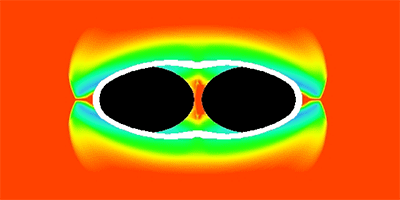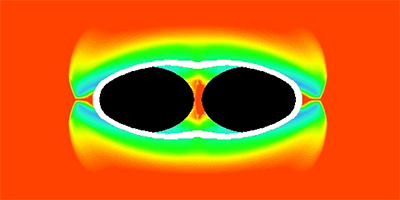Black Holes Emerge from Collisions
A high-speed collision between particles can, theoretically, concentrate enough mass and kinetic energy in one place that a black hole can form. Physicists have considered this possibility for some time, but new dynamical simulations show that the amount of collisional energy needed is 2.4 times less than previously assumed. The authors, reporting in Physical Review Letters, explain that the colliding objects act like gravitational lenses on each other, focusing the energy into two light-trapping regions that eventually coalesce into a single black hole.
In 2008, the public became concerned over a reported risk of Earth-gobbling black holes forming when relativistic protons collided at the Large Hadron Collider (LHC) in Geneva, Switzerland (see 18 August 2008 Viewpoint). Technically speaking, the collider’s energy is far too low for black hole formation, but certain models allow for the creation of very small (benign) holes. In any case, the controversy has subsided after several years of “black-hole-free” operation at the LHC, but interest still remains in the theoretical possibilities.
Previous studies calculated the kinetic energy needed in a collision to make a black hole, but little attention was given to the internal dynamics that specifies where the collisional debris ends up. William East and Frans Pretorius of Princeton University, New Jersey, performed computer simulations of a head-on collision between two fluid “drops,” which serve as generic particles. The simulations showed that the gravity of the drops causes energy to converge—and become trapped—at two “focal points” on opposite sides of the collision center. The points subsequently merge together into a black hole with 72% of the total energy (much of the rest radiates away as gravitational waves). The lensing effect reduces the threshold energy, which could have bearing on ongoing searches for black hole signatures at the LHC. – Michael Schirber





